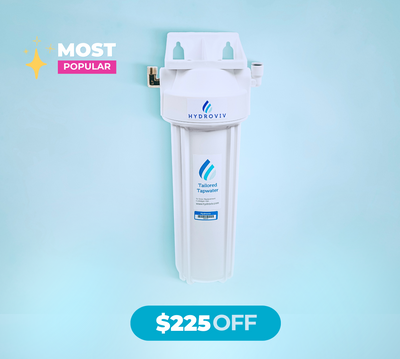Hydroviv's 2020 PFAS Update
RSS
*Updated 1/22/20 to include EWG map*
Analies Dyjak, M.A. | Policy Nerd
The Environmental Working Group (EWG) recently updated its map of PFAS effected communities, which includes an extensive list of new cities. Residents, city and state officials, and the federal government are working to figure out how to respond. We wanted to provide an update as to what’s going on with PFAS contamination in the nation's drinking water.
What Are PFAS And Why Are They Dangerous?
Per and Polyfluoroalkyl Substances (PFAS) are a category of emerging contaminants and are both mobile and persistent in the environment. PFAS are found in a variety of products including Scotchguard, Teflon, firefighting foam, metal plating, heat and water repellent products, and stain resistant fabrics. Health effects associated with PFAS contaminated drinking water are becoming more widely accepted throughout regulatory bodies. According to the Agency for Toxic Substance and Disease Registry, PFAS are associated with a long list of health effects including an increased risk of cancer, lowered fertility rates, increased cholesterol, and developmental issues in young children and infants.
PFAS Action Act of 2019
At the beginning of January, 2020, the U.S. House of Representatives passed the most sweeping piece of PFAS legislation to date. The PFAS Action Act of 2019 is sponsored by Representative Debbie Dingell (D-Mich). The bill is currently making its way through the legislative process and waiting on a senate vote.
If this legislation passes, the following would happen:
- EPA would be required to set a national standard under the National Primary Drinking Water Standards for both PFOA and PFOS.
- EPA would require action under its Superfund program, also known at the Comprehensive Environmental Response Compensation and Liability (CERCLA) to hold responsible parties accountable for mitigation.
- EPA would be required to designate all PFAS as “hazardous air pollutants” under the Clean Air Act.
- EPA would be required to authorize funding ($500 million over five years) to help municipalities across the country comply with new PFAS laws.
How Will The PFAS Action Act Impact My Community?
There is no denying that this bill has the potential to be a huge win for communities across the country. It’s sweeping scope will force states to acknowledge a problem that has been ignored for years. However, it is important to point out some of the things this bill will not accomplish. Like all other National Primary Drinking Water Standards, private wells are not covered under this proposed bill. This major oversight puts millions of Americans at risk. Homeowners who drink from private wells are responsible for testing, monitoring, and removing any potentially harmful contaminants from their water, whereas those on city water rely on their municipalities' water treatment capabilities.
Then there is the cost of removing PFAS at the municipal level. The Cape Fear Public Utility Authority in Wilmington, North Carolina spent $35.9 million for PFAS removal equipment at one of their three water treatment facilities. Even with the $500 million added to a state-revolving fund, the PFAS Action Act would place a serious financial burden on municipalities.
Key Players: Department of Defense
The Department of Defense is also leading the charge to address PFAS, which might be surprising considering they have played a large role in contributing to the problem. PFAS are a key ingredient in firefighting foam which is often used for training purposes on military bases. Many bases do not rely on the public system for drinking water, but rather have their own dug wells for military families. DoD has created an inventory of bases and wells show levels of PFAS. As of August 2017, DoD identified 401 military installments that are suspected to have released PFAS. That being said, DoD has spent $200 million on investigating and mitigating these releases since the contamination has became public.
The National Defense Authorization Act, which includes the annual military budget for 2020, prohibits the Department of Defense from using PFAS-containing firefighting foam starting October 1, 2022. DoD is also funding research to come up with an alternative to PFAS. The twist, however, is military bases are not required to comply with federal and state drinking water standards. Even if a federal regulation were to be set, it would be under the discretion of DoD to determine how to proceed.
PFAS Update: Is A Regulation Coming?
Possibly. It typically takes decades for EPA to regulate a contaminant under the National Primary Drinking Water Standards. For example, Chromium 6 still remains unregulated after decades spent in the regulatory funnel. Additionally, Chromium 6 was highlighted in the 2000 blockbuster film Erin Brockovich, starring Julie Roberts. Despite widespread attention on these contaminants, drinking water regulations take such a long time in part due to push back from chemical manufacturers and industry who produce these types of toxic contaminants. In 2018, EPA set a non-enforceable health advisory level of 70 parts per trillion. An important caveat is public health goals, guidance levels, and health advisory levels are all non-enforceable, and therefore municipal water systems do not need to comply. That being said, a regulation submitted to the Office of Information and Regulatory Affairs (OIRA) was recently sent back to the Environmental Protection Agency for revisions, or to be published in the Federal Register.
States Leading the Charge
In 2019, several states in the U.S. stepped up to tackle PFAS head on. Because there is no federal consensus on what the standard should be, it is at the discretion of states to determine an acceptable level in drinking water. States run into similar obstacles as the federal government when setting standards. It is important to remember that as of now right now, most state standards are non-enforceable public health goals or advisory levels. Minnesota in particular has done a great job paving the way for other states. In 2018 Minnesota settled with 3M, a major manufacturer of PFAS in an $850 million lawsuit.
Our Take:
The bottom line is removing PFAS at the municipal level is expensive. Even if these regulations were enacted, communities would need to solve the problem of purchasing multi-million dollar equipment. Financial roadblocks are just one of the hurdles that EPA needs to overcome when developing a benefit-cost analysis: For example, do the benefits associated with regulating PFAS outweigh the costs? This factor is heavily examined when a regulation is being considered.
The current arsenic standard is the best example of this. EPA scientists agreed on establishing the Maximum Contaminant Level (MCL) as 3 parts per billion for arsenic in drinking water, which is consistent with public health recommendations. Ultimately the agency settled on the current level of 10 parts per billion because they could not justify the cost of removing arsenic at the municipal level with the health benefits.
Only a handful of communities have been able to purchase this type of expensive equipment. For example, the public utility for Wilmington, North Carolina purchased a $46 million Granular Activated Carbon (GAC) filtration system. This type of investment is not viable for most communities in the United States.
Other Articles We Think You Might Enjoy:What Are Per and Polyfluoroalkyl Substances?
Military Bases Have High Levels of PFAS
EPA Admits GenX Linked To Cancer


